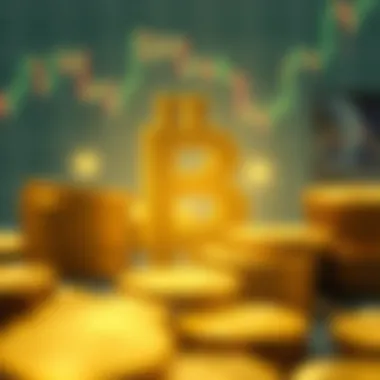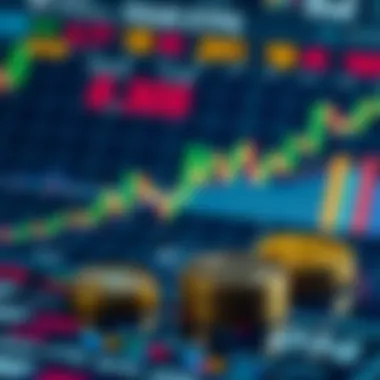Understanding Rouble ETFs and Their Role in Investment


Intro
In today’s financial landscape, the buzz around Exchange-Traded Funds (ETFs) is palpable, yet many may not grasp the nuances of Rouble ETFs. These unique instruments provide investors an entry point into the Russian market, but they come with complexities that warrant deeper examination. Amid the surge in interest for cryptocurrencies and global finance, understanding Rouble ETFs becomes more than just a necessity—it’s a strategic advantage. This article will peel back the layers on Rouble ETFs, providing insights into their structure, market behavior, and how they fit into broader investment strategies.
Understanding Cryptocurrency Concepts
Exploring the world of finance today inevitably leads to discussions on cryptocurrency. This section aims to lay the groundwork by explaining essential concepts, ensuring every investor is equipped with the right knowledge.
Blockchain Technology Explained
At the heart of cryptocurrency lies blockchain technology. Simply put, a blockchain is a decentralized and distributed digital ledger that records transactions across many computers. This means that once a transaction is entered, it cannot be altered without the consensus of all participants, fostering transparency and security. In relation to Rouble ETFs, understanding this technology helps investors appreciate how these funds might utilize blockchain to enhance their operational efficiency and transparency.
Key Terms Every Investor Should Know
Before diving into Rouble ETFs, it’s critical to familiarize yourself with some terms that frequently pop up:
- ETFs: Funds that can be traded on stock exchanges, much like individual stocks. They typically track an index, commodity, or a basket of assets.
- Cryptocurrency: Digital or virtual currency that uses cryptography for security.
- Decentralization: The distribution of authority or control away from a central figure or entity.
- Liquidity: Refers to how easily an asset can be converted to cash without affecting its market price.
These terminologies will prove vital as we navigate through the specifics of Rouble ETFs and their significance in diversifying investment portfolios.
Market Analysis and Trends
Navigating the investment landscape requires a keen eye on market movements. This section will delve into current trends and strategic approaches relevant to Rouble ETFs.
Current Market Trends in Cryptocurrency
As cryptocurrencies continue to gain traction globally, Rouble ETFs have emerged as a bridge for investors interested in the Russian market. With the rise of digital currencies, especially in times of economic uncertainty, more individuals are looking for alternative investment options. Currently, notable trends include:
- Increased institutional investment in cryptocurrencies, pushing the demand for more indexed products like ETFs.
- A surge in regulatory discussions around crypto-assets, affecting investor confidence and strategies.
- The volatile nature of cryptocurrency prices creating opportunities for savvy investors—but also substantial risks.
Investment Strategies for Different Market Conditions
When it comes to investing, one size does not fit all. Different market conditions require tailored strategies. Here are a few approaches investors might consider with Rouble ETFs:
- Bull Market: In a rising market, increased exposure to Rouble ETFs can enhance potential returns, but investors should be cautious of overheating.
- Bear Market: In declining markets, Rouble ETFs may act as a hedge against losses, provided that the underlying assets remain stable.
- Diversification: Incorporating Rouble ETFs into a diversified portfolio can mitigate risks, especially for those heavily invested in Western markets.
"The beauty of Rouble ETFs lies in their ability to offer exposure to a historically volatile yet rich market, underscoring the necessity for strategic investment plans."
Prologue to Rouble ETFs
In recent years, Rouble ETFs have gained traction among investors looking to harness the potential of the Russian financial market while navigating the complexities of global investing. Understanding these investment vehicles is crucial for anyone keen on staying ahead in an ever-evolving environment.
Rouble ETFs, or exchange-traded funds focused on the Russian currency, offer a unique blend of benefits that cater to various investment strategies. They serve as a bridge for investors who want exposure to the Russian economy without the intricacies that direct investments might entail.
One of the primary advantages of Rouble ETFs is the diversification they provide. By including a basket of securities denominated in Roubles, investors can mitigate individual stock volatility. This collective safety net can be appealing, particularly in emerging markets known for their swings. Additionally, Rouble ETFs often boast a more attractive fee structure compared to traditional mutual funds, which can eat into an investor's returns if not managed properly.
However, investing in Rouble ETFs is not without its concerns. Investors must remain attuned to geopolitical factors. The interplay between international relations and the Russian economy can drastically affect ETF performance, and being caught off guard can have detrimental effects on an investor’s portfolio. Moreover, currency fluctuations can complicate returns, especially for clients dealing with denominated currencies different from the Rouble. Understanding these risks is as important as recognizing the growth potential.
In summary, Rouble ETFs represent a fascinating opportunity within the investment landscape. Whether you are an astute trader or a passionate educator, grasping their intricacies will enhance your investment approach. Investors need to evaluate their risk tolerance and investment goals when considering Rouble ETFs, ensuring these products align with their broader strategy.
"Investing is more about understanding the landscape than picking the next big thing."
With this foundation laid, let's delve deeper into the essence of ETFs and how Rouble ETFs carve their niche in today's financial market.
The Mechanism of Rouble ETFs


Understanding the mechanism behind Rouble ETFs is crucial for grasping how they function within investment strategies. These instruments are more than just a means of exposure to the Russian economy; they serve as a bridge connecting complex financial systems. The mechanism includes components like underlying assets and the creation and redemption process, which collectively mold the investment experience and potential returns for investors.
Underlying Assets
The foundation of any ETF is its underlying assets, and Rouble ETFs typically hold a mix of securities tied to the Russian economy. Common assets include stocks from various sectors, bonds, and even commodities. Notably, companies like Gazprom and Lukoil often feature prominently, given their substantial roles in the energy market.
When investors purchase shares of a Rouble ETF, they are indirectly investing in these individual assets. This setup allows for diversification, reducing the risk tied to any single asset while tapping into broader market trends. For example, an investor might ride out volatility in one sector because other holdings in the ETF might be performing better.
However, the selection of underlying assets is influenced by factors such as geopolitical events and economic sanctions. An abrupt change in these factors can impact asset performance, making it vital for investors to keep abreast of news related to Russian market conditions.
"Investing in Rouble ETFs means placing a bet not just on the currency, but on the stability of Russia’s economic environment, which is often as unpredictable as it is rich in potential."
Creation and Redemption Process
The creation and redemption process is a vital mechanism that defines ETFs, including those associated with the Rouble. Essentially, authorized participants—usually large financial institutions—play a critical role by assembling groups of underlying assets. They then exchange these assets for ETF shares. This approach allows the ETF to keep its price close to the net asset value (NAV) of the underlying assets.
On the redemption side, if the market price of the ETF shares dips below the NAV, authorized participants can redeem shares for the underlying assets. This acts as an automatic balancing mechanism in the market. Consequently, it prevents the ETF from diverging too far from the actual value of the assets it represents.
This process is particularly significant in the context of Rouble ETFs due to the potential volatility in the Russian financial markets. Rapid changes in investor sentiment can lead to swift movements in fund flows, compelling the mechanism to function efficiently to maintain stability.
Investors should recognize that both the creation and redemption processes are reflections of broader market trends. Increased buying activity could signify bullish sentiment, while sell-offs often indicate market trepidation. Thus, observing these processes can offer valuable insights into market psychology.
At the end of the day, understanding the mechanism of Rouble ETFs helps investors better navigate the intricate landscape of Russian financial assets. Being informed about the underlying assets and the creation/redemption process not only aids in making smart investment choices but also enhances one’s grasp of market dynamics.
Investment Appeal of Rouble ETFs
Rouble ETFs present a compelling avenue for investors looking to diversify their portfolio and navigate the complexities of global markets. The significance of these financial instruments lies not just in their structure, but in the unique opportunities they offer in a fluctuating economic environment. Considering the Russian rouble’s historical volatility, exposure through ETFs can help mitigate risks associated with direct investment in underlying assets.
Diversification Benefits
One of the primary advantages of Rouble ETFs is their potential for diversification. By investing in Rouble ETFs, buyers are not just banking on a single currency or set of assets; they gain exposure to a variety of securities tied to the Russian economy. This spreads the risk across multiple sectors, reducing the overall impact of a downturn in any one sector.
Moreover, Rouble ETFs often include not only government bonds but also equities from various industries such as energy, finance, and technology. This inherent diversification can create a balanced investment approach, where strong performance in one area might offset potential losses in another. As markets are unpredictable, having this sort of buffer is a prudent strategy for both novice and veteran investors alike.
Cost Efficiency
Cost efficiency is another key appeal of Rouble ETFs. Unlike traditional investment vehicles, which can involve large broker fees and minimum investment amounts, ETFs generally offer lower expense ratios and trading fees. This makes it easier for individual investors, who might be wary of high costs eating into their returns, to enter the market.
Moreover, Rouble ETFs can be traded throughout the day like stocks, providing flexibility in timing decisions. This flexibility often leads to better price execution compared to traditional methods. Even more appealing is the option to purchase fractional shares, which allows smaller investors to gain access to a market that may have seemed out of reach before.
Access to Emerging Markets
Investing in Rouble ETFs not only grants exposure to the Russian economy but also serves as a gateway to emerging market dynamics. With Russia being one of the largest economies in the world, tapping into its financial products can lead to unique investment opportunities that may not be readily available through other markets.
Emerging markets offer the prospect of high growth potential, although they come with their share of risks. Through Rouble ETFs, investors can hold a stake in industries poised for growth, such as natural resources and technology, without putting their capital at excessive risk. This access is particularly valuable for those seeking to broaden their investment horizon and exploit potential gains in regions experiencing rapid economic development.
"Investing in Rouble ETFs can be like fishing in rich waters; the right bait can reel in spectacular returns."
In summary, Rouble ETFs stand out in the investment landscape by offering diversification, cost efficiency, and access to emerging markets—all critical factors for savvy investors. As this market evolves, understanding these appeals becomes essential for making informed investment decisions.
Comparing Traditional ETFs with Rouble ETFs
In the complex world of investment, comparing Rouble ETFs to traditional ETFs provides vital knowledge for investors looking to optimize their strategies. This comparison brings to light the distinct advantages and potential pitfalls associated with each type of fund. Understanding these nuances can help investors make informed choices, ensuring their portfolios are well-balanced and aligned with their financial goals.
Similarities in Structure


At first glance, Rouble ETFs and traditional ETFs might appear similar. Both types of funds are designed to track the performance of a basket of assets. The structure of each typically includes:
- Diversified Holdings: Both ETFs aim to provide investors with access to a variety of securities. While traditional ETFs often focus on equities or bonds, Rouble ETFs primarily incorporate assets denominated in roubles, which can include local stocks, bonds, and commodities.
- Exchange-Traded Nature: Like their traditional counterparts, Rouble ETFs are traded on stock exchanges. This allows investors to buy and sell shares throughout the trading day, enabling liquidity and flexibility in investment decisions.
- Management Fees: Both types of ETFs usually charge management fees, though these fees can vary significantly between Rouble ETFs and their traditional equivalents based on their structure and underlying assets.
Despite these structural similarities, the actual composition and market focus significantly diverge, setting the stage for a different investment experience.
Differences in Market Behavior
Examining the behavioral patterns of Rouble ETFs compared to traditional ETFs reveals crucial distinctions influenced by varying market forces. Investors must consider factors such as:
- Market Context: Traditional ETFs often operate in more established markets, allowing them to move in tandem with broader economic indicators. Conversely, Rouble ETFs are subject to localized economic conditions, making their performance highly responsive to regional events and trends.
- Volatility: Rouble ETFs can exhibit higher volatility compared to traditional ETFs. This is due to the nature of the assets involved and their vulnerability to geopolitical tensions, currency fluctuations, and changes in investor sentiment toward emerging markets. Investors need to brace themselves for potential price swings that can be more pronounced than those found in traditional ETF holdings.
- Liquidity Concerns: While many traditional ETFs benefit from substantial trading volumes, some Rouble ETFs may experience lower liquidity, particularly if they focus on niche markets or less widely traded securities. This can make it challenging for investors looking to enter or exit positions without impacting the price significantly.
An essential takeaway is that while the structural framework of Rouble ETFs is akin to traditional ETFs, their market behaviors stem from distinct economic factors that require careful consideration.
In summary, the comparison of Rouble ETFs with traditional ETFs uncovers both foundational similarities and crucial divergences. Understanding these aspects can enhance an investor's approach when incorporating these financial instruments into their broader investment strategy. Future sections will further explore the risks associated with Rouble ETFs, adding another layer of insight to the ongoing discussion.
Risks Associated with Rouble ETFs
Investors stepping into the domain of Rouble ETFs must grapple with a spectrum of risks intertwined with these unique financial instruments. Understanding these risks is paramount, not just for safeguarding investments but also for making informed decisions in a volatile market. Beyond the surface allure of potential high returns, the nuanced landscape reveals challenges, which can derail even the most meticulously planned investment strategy.
Market Volatility
Volatility is essentially the name of the game in the realm of Rouble ETFs. The Russian economy, tied closely to natural resources like oil and gas, has its ups and downs. Political events, changes in global commodity prices, and shifts in investor sentiment can cause sharp price swings. Such fluctuations mean that investors might experience significant gains or losses over very short periods.
Investing in Rouble ETFs can, at times, resemble a rollercoaster ride. It's essential to keep an eye on the broader economic factors at play. For instance, if the price of oil plummets due to global overproduction, not only does it endanger the Russian economy, but it also adversely impacts Rouble ETF values.
"In the world of Rouble ETFs, a sound investment strategy hinges on one's ability to navigate through the stormy seas of market volatility."
Keeping a diversified portfolio can help mitigate some of this risk, but a keen awareness of the macroeconomic factors is crucial. One might say that it’s like being a ship captain needing to read the wind and waves to steer safely.
Currency Risk
Currency risk is another layer that adds complexity to investing in Rouble ETFs. Since these ETFs derive their value from the Rouble, any fluctuations in the currency's value can directly impact investor returns. For instance, if the Rouble depreciates against major currencies like the dollar or euro, the returns on Rouble assets might look less impressive when converted back to those currencies.
The interplay between the Rouble and international currencies can lead to unexpected scenarios. Economic sanctions, changes in interest rates, or inflation differentials can affect the Rouble's strength. Savvy investors need to be aware of these dynamics, akin to understanding the local dialect when abroad—essential for making informed decisions.
Geopolitical Risk
Geopolitical risk looms large over the landscape of Rouble ETFs. Russia’s relationship with the West, and the implications of international sanctions, can drastically impact the stability and attractiveness of investments in Rouble-based assets. Investors should monitor the geopolitical climate closely; escalating tensions can lead to market downturns and unpredictable shifts in asset values.
In situations where geopolitical stakes run high, such as military engagements or trade conflicts, investments in Rouble ETFs may become particularly precarious. The ripple effects can be felt not only through direct sanctions on Russian entities but also through broader market reactions. A thoughtful investor must approach this risk like a chess player, constantly assessing potential moves and counter-moves.
Understanding the risks associated with Rouble ETFs is not merely an academic exercise; it’s vital for anyone considering this investment vehicle. By grasping the nuances of market volatility, currency fluctuations, and geopolitical tensions, investors can craft strategies that safeguard their capital amid the tumult of the financial markets.
Performance Analysis of Rouble ETFs
Performance analysis is a critical dimension in understanding Rouble ETFs, carrying considerable weight for investors looking to gauge the viability and risk associated with these financial instruments. As the financial landscape continues to evolve, Rouble ETFs present unique opportunities and challenges, making their performance a focal point for trade strategies. Analyzing their past and present performance provides insight into potential future trends, thus serving both seasoned and novice investors in decision-making processes.
When evaluating Rouble ETFs, one must consider several key factors:
- Market trends: Understanding historical patterns is essential to predicting future movements.
- Risk assessment: Performance data can assist in evaluating the inherent risks linked to geopolitical or economic changes.
- Investment strategies: Different strategies can be employed based on historical performance, informing the best approach to maximize potential gains while minimizing risk.
The following sections delve deeper into the past performance data of Rouble ETFs, as well as how they stand up competitively against other investment assets.
Historical Performance Data


Historically, the performance of Rouble ETFs can be quite telling. For instance, during periods of economic upheaval in Russia and surrounding regions, these ETFs have exhibited high levels of volatility. Investors might find it important to look back at specific timelines, such as the impact of Western sanctions or sudden market shocks, which can heavily influence the Rouble's strength and, consequently, the performance of Rouble ETFs.
Analyzing data from multiple years helps to paint a clearer picture:
- 2014: This year marked significant turbulence for the Rouble, which had a direct impact on Rouble ETFs.
- 2020-2021: The global pandemic saw fluctuations that tested the resilience of these funds, showcasing both volatility and recovery potential.
Investors might track indices and average returns each year to understand trends more clearly. A comprehensive review of historical performance provides invaluable data that can indicate the overall liquidity of the ETFs, investor sentiment, and potential growth rates.
Comparative Analysis with Other Assets
When it comes to understanding where Rouble ETFs stand in the broader market context, comparative analysis is invaluable. By juxtaposing Rouble ETFs against other assets, such as traditional equities, commodities or even other currency ETFs, investors can yield more robust insights about their attractiveness as investment vehicles.
- Equities vs. Rouble ETFs: Equities in established markets might demonstrate stability, whereas Rouble ETFs could present higher volatility yet offer greater reward potential in emerging markets.
- Commodity Comparison: With commodities like gold often acting as safe havens in turbulent times, comparing these to Rouble ETFs in times of geopolitical strain can shed light on investor preferences and perceptions of risk.
- Currency ETFs: Both Rouble and other currency ETFs can vary greatly in response to macroeconomic indicators, with Rouble ETFs often showing distinct responses to local and foreign policy changes.
By analyzing these contrasting performance metrics, investors can make more informed choices about which assets to include in their investment portfolios.
"Performance is not about how much you invest, but how wisely you manage your investments in the face of uncertainty."
In summary, understanding past performance and making comparative analyses empowers investors when determining the role of Rouble ETFs in their diversified strategies. The value of examining these parameters cannot be overstated; they provide critical context and strategic direction.
Future Trends in Rouble ETFs
As the global financial landscape continues to evolve, Rouble ETFs are becoming increasingly relevant. This section focuses on the future trends surrounding these investment vehicles and examines their potential implications for investors. Given the rapid pace of change, understanding these trends is essential for making informed investment choices. The interplay of regulatory developments and market adaptations can greatly influence how Rouble ETFs function and their attractiveness to investors.
Impact of Regulatory Changes
Regulatory changes are pivotal when discussing the future trends of Rouble ETFs. Each nation's policies can significantly shape the operation and appeal of these financial instruments. Regulatory bodies in Russia and the wider investment community globally keep an eye on the cryptocurrency and financial markets, with policies that can either bolster or hamper growth.
- Increased Oversight: Investors should expect greater scrutiny from regulatory agencies. This could mean more stringent requirements for disclosures, which can enhance the credibility of Rouble ETFs.
- Tax Implications: Potential changes in tax treatment could influence investor behavior. If the regulations become more favorable for ETF investments in Russia, it may lead to an uptick in participation.
- Cross-Border Regulations: With the global nature of finance today, new rules governing international investments could impact Rouble ETFs. Navigating these waters is crucial for both issuers and investors.
“Regulatory bodies have a tremendous influence on the investment landscape; their actions can either catalyze market growth or lead to stagnation.”
Adaptation to Market Trends
The financial market's appetite for dynamic instruments like Rouble ETFs suggests they will need to adapt to prevailing trends continuously. Keeping an ear to the ground on investor sentiment, market performance, and technology will help Rouble ETFs remain relevant.
One of the key trends is the movement towards sustainability. As investors increasingly prioritize environmental, social, and governance (ESG) factors, Rouble ETFs need to align with these values to attract funds.
Additionally, the rise of digital assets continues to reshape traditional investment frameworks. Rouble ETFs might integrate more blockchain technologies, enhancing security and efficiency in trading.
Key Adaptations to Watch:
- Integration with Fintech: Collaborations between financial technology and Rouble ETFs could improve user experience and expand market outreach.
- Emerging Market Focus: With investors looking to diverse portfolios, Rouble ETFs could focus on specific sectors within emerging markets that show promise.
- Enhanced Visibility: Marketing and outreach efforts will likely increase as issuers aim to inform a broader audience about the benefits of investing in Rouble ETFs.
As the market shifts, Rouble ETFs must be flexible to adapt or risk becoming obsolete. The importance of anticipating these changes cannot be understated, as they will dictate the strategies pursued by investors going forward.
The End
In wrapping up this exploration of Rouble ETFs, it's essential to recognize how these investment vehicles present a unique blend of opportunities and challenges. By facilitating access to a range of assets tied to the Russian economy, Rouble ETFs allow investors to diversify their portfolios with relative ease. However, they also alert us to the risks lurking behind geopolitical tensions and currency volatility. Understanding these factors is pivotal not only for seasoned investors but also for newcomers who may be looking at these instruments with fresh eyes.
Summarizing Key Insights
A few key points have emerged throughout our discussion:
- Investment Potential: Rouble ETFs cater to those wanting exposure to Russian markets without the complexities of direct investment. They make it easier to tap into sectors like natural resources and manufacturing, which can perform differently based on global demand.
- Risks to Consider: As with any investment, understanding the affiliated risks is crucial. Market volatility can significantly affect the performance of Rouble ETFs. Currency risk, particularly in light of current sanctions and geopolitical issues, further complicates the landscape for potential gains.
- Future Directions: With changing regulations and the trends toward digital assets, Rouble ETFs might evolve, impacting their effectiveness as investment tools. Keeping an eye on these developments is vital for those looking to maintain an edge in the investment sphere.
The synthesis of these insights reinforces the importance of keeping a well-rounded perspective on Rouble ETFs as part of an overall investment strategy. Their significance, when grasped properly, can lead to informed decisions that align with an investor's goals.
Final Thoughts on Rouble ETFs
Investors should approach Rouble ETFs with a dual perspective: excitement for the potential benefits and caution for the associated risks. Evaluating local market sentiments, political dynamics, and global economic trends can provide investors with a more robust framework for decision-making.
Ultimately, Rouble ETFs might not fit every investor's profile, yet they are undeniably significant within the broader narrative of diversification and exposure in investment strategy. As the market continues to evolve, so too should the strategies of investors looking to capitalize on global opportunities.















